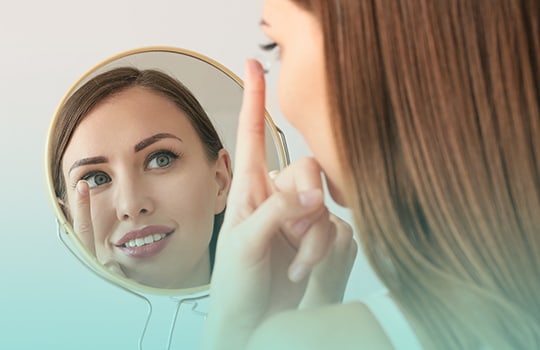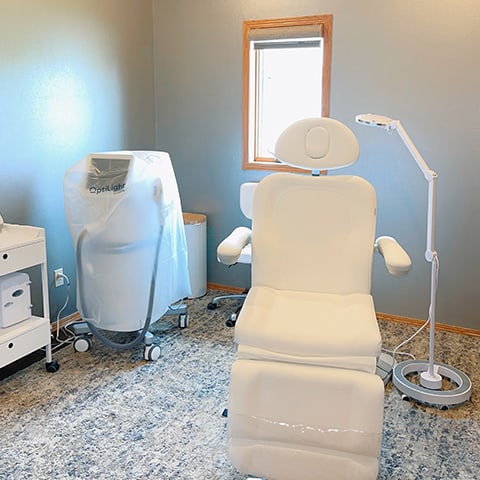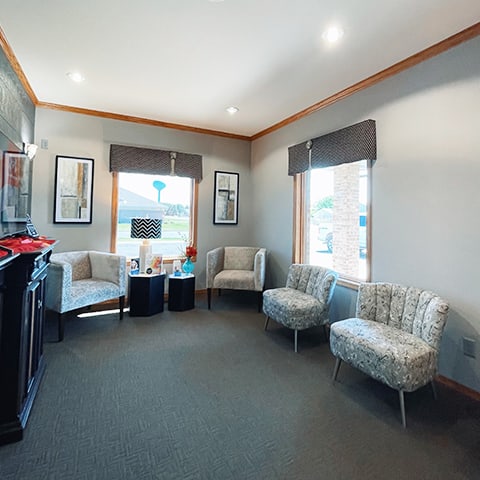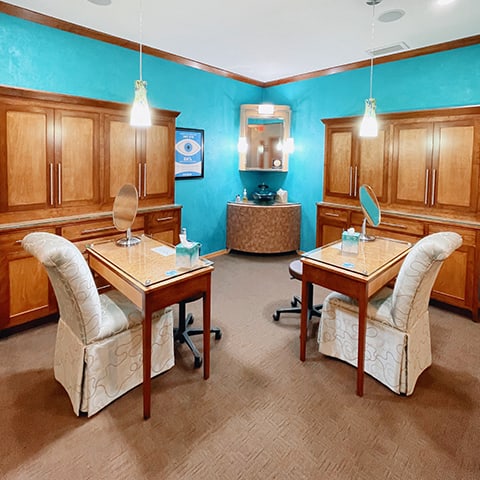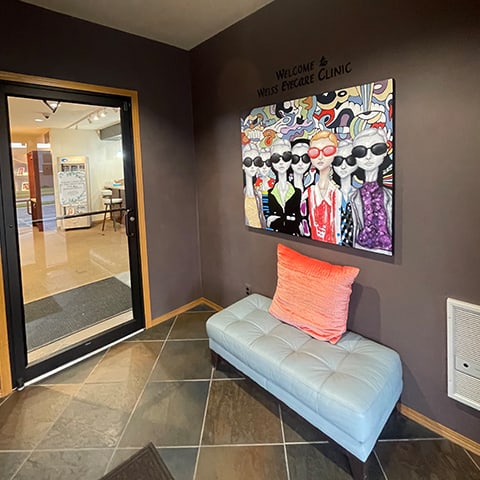It’s Never too Early for Eye Health
It’s never too early to focus on your children’s eye health and vision. Their sense of sight is vital at every age and every stage of development.
Children might be nervous about their eye exams. Rest assured, our optometrist is experienced with children and can put them at ease. It’s important to give them a positive impression of the optometrist early on in life so they feel comfortable coming for regular appointments.
If your child does need glasses, we offer a wide selection of colors and styles that will make them smile.
Book their appointment today to set them up for success—and a lifetime of healthy vision.
Book AppointmentWhen Do Children Need Eye Exams?
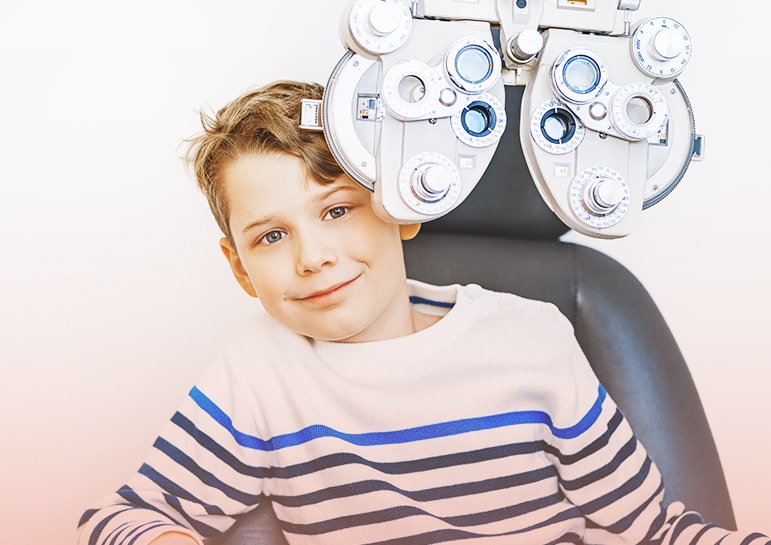
The American Optometric Association recommends that children have exams at the following intervals:
- A comprehensive exam to establish a baseline between the ages of 6 and 12 months
- Another comprehensive exam as they grow and develop between the ages of 3 and 5
- Annual, comprehensive exams starting before 1st grade until adulthood
Proper vision is essential for children’s success—in life and academics. Beyond just seeing what’s in front of them at school, visual skills are needed for social, cognitive, and motor skill development.

Children’s Vision Issues & Stages of Sight
Several vision conditions can develop in childhood and can impact eyesight. Our experienced optometrists can diagnose and recommend treatment for a variety of vision issues, including the following.
Myopia (Nearsightedness)
Myopia (nearsightedness) begins in childhood and can continue to develop until vision stabilizes in adulthood. High myopia increases the risks of more serious conditions later on, and children with undiagnosed myopia can struggle in school.
Most children with myopia received a diagnosis before the age of 12, making children’s eye exams a key component of addressing the condition early on. While it cannot be cured, myopia can be controlled if detected early.
Strabismus (Crossed Eyes)
A muscle condition known as strabismus is usually the culprit when the eyes are crossed. It generally means the eyes are not working together properly. Sometimes, the condition is obvious as one eye turns in a different direction.
Strabismus does not get better on its own and requires intervention from an optometrist to rectify.
Amblyopia (Lazy Eye)
Amblyopia, also known as a lazy eye, occurs when there is a large difference in prescription between each eye. Over time, the connection between the brain and affected eye decreases, as one eye consistently provides poor images.
Treatment, such as patching the good eye and forcing the brain to connect with the weaker one, can almost always resolve this condition.
Convergence Insufficiency
When blurry or double vision is present, convergence insufficiency may be the reason. Convergence insufficiency occurs when the eyes don’t work together while looking at nearby objects or up-close work.
An eye exam is imperative to detect convergence insufficiency, as it occasionally presents without visual cues.
Stages of Sight
There are many milestones in a baby’s visual progression. Here’s what to expect at some important stages:
- Birth to 4 Months: Your baby’s vision improves rapidly at this stage. They should be focusing on nearby objects and faces and begin reaching for things.
- 5 to 8 Months: A 3-dimensional view of the world begins to form, as does color vision.
- 9 to 12 Months: Babies begin to grasp objects and can judge distances.
- 1 to 2 Years: Hand-eye coordination and depth perception should be well-developed.
As babies grow and develop, you can help encourage their healthy visual development by playing games like peek-a-boo and patty-cake, providing objects that can be explored with the hands, and playing games that include dropping things and picking them up.
To ensure your child develops visual skills at the appropriate pace, be sure to bring them in for comprehensive eye exams.
How Do I Know If My Child Needs Glasses?
If a child experiences a vision issue, they are often unable to articulate the problem—they might not even know there is a problem. Unlike adults, children have not established a baseline of what proper vision looks like for them.
Bringing your child for regular eye exams can help establish that baseline. We can help detect any vision problems early on. Book their appointment today!
Book AppointmentOur Location

Our Address
- 1300 19th St NE
- Watertown, SD 57201
Contact Information
- Phone: 605-882-0808
- Fax: 605-882-7078
- Email: office@weisseyecareclinic.com
Our Hours
- Monday: 8:30 AM – 6:00 PM
- Tuesday: 8:30 AM – 5:00 PM
- Wednesday: 9:30 AM – 5:00 PM
- Thursday: 8:30 AM – 5:00 PM
- Friday: 8:00 AM – 1:00 PM
- Saturday: Closed
- Sunday: Closed

Our Brands








Our Google Reviews
Our Blogs
Regular Vs. Specialty Contact Lenses: Know The Difference
UncategorizedAs an alternative to eyeglasses, contact lenses can effectively and conveniently correct poor vision. Unfortunately, certain eye conditions make it difficult to wear regular contact lenses. The good news is that R&D labs have been busy finding solutions for individuals with hard-to-fit eyes. The result: specialty contact lenses that are ideal for those with various […]
Symptoms Of A Foreign Body In The Eye: Pain, Irritation, Redness, And MoreSymptoms Of A Foreign Body In The Eye: Pain, Irritation, Redness, And More
UncategorizedAnything that gets into any part of your eye is a foreign body. It can be the occasional eyelash, sand, dirt, or glass. They are all objects that are not naturally found in the eye. It depends on the size and type of material, but a foreign body can cause minor irritation, bleeding, or even […]
Treatment Options for Managing Dry Eye Syndrome
UncategorizedThe field of eye care has come a long way in understanding and treating dry eye. There were limited treatment options in the past, but today, there are many ways to manage this condition. However, finding the proper treatment can be a process of trial and error. That is because dry eye causes and triggers […]
Regular Vs. Specialty Contact Lenses: Know The Difference

As an alternative to eyeglasses, contact lenses can effectively and conveniently correct poor vision. Unfortunately, certain eye conditions make it difficult to wear regular contact lenses. The good news is that R&D labs have been busy finding solutions for individuals with hard-to-fit eyes. The result: specialty contact lenses that are ideal for those with various […]
Symptoms Of A Foreign Body In The Eye: Pain, Irritation, Redness, And MoreSymptoms Of A Foreign Body In The Eye: Pain, Irritation, Redness, And More

Anything that gets into any part of your eye is a foreign body. It can be the occasional eyelash, sand, dirt, or glass. They are all objects that are not naturally found in the eye. It depends on the size and type of material, but a foreign body can cause minor irritation, bleeding, or even […]
Treatment Options for Managing Dry Eye Syndrome

The field of eye care has come a long way in understanding and treating dry eye. There were limited treatment options in the past, but today, there are many ways to manage this condition. However, finding the proper treatment can be a process of trial and error. That is because dry eye causes and triggers […]


